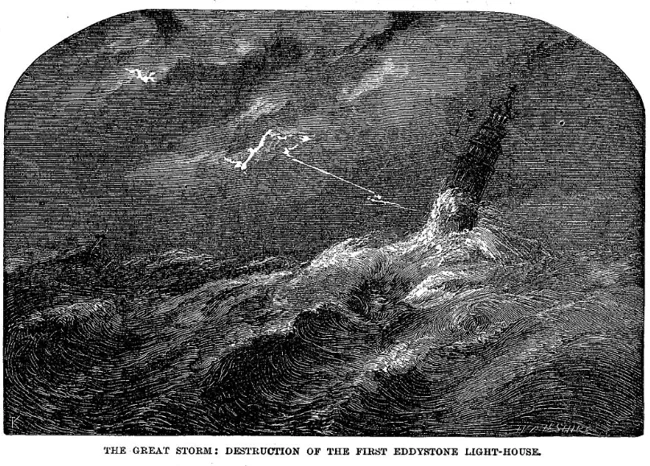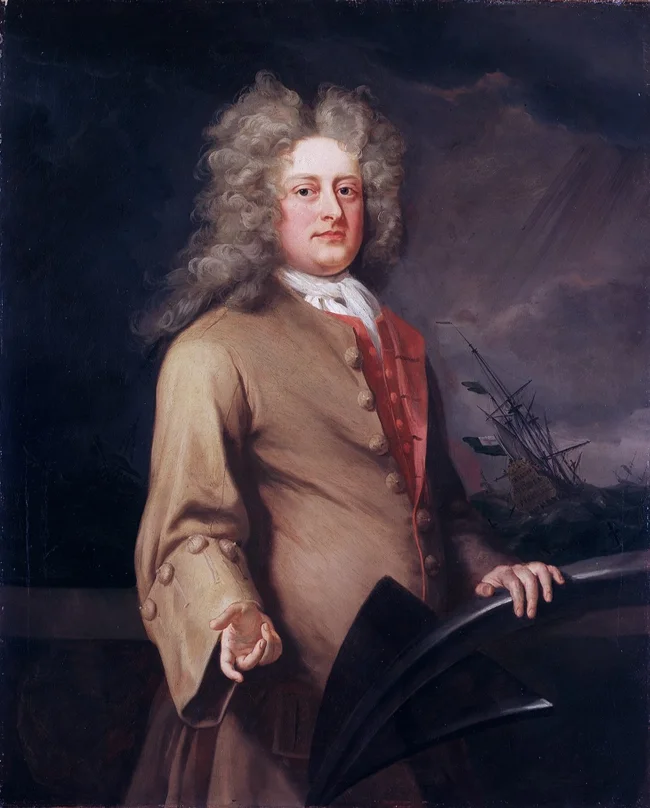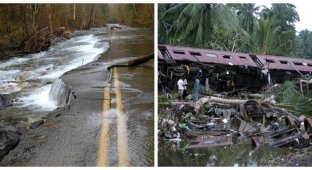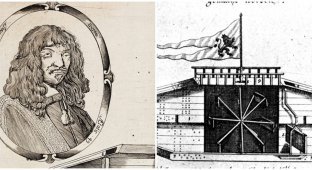A disaster for the British fleet. The Great Storm of 1703 (4 photos)
Changes in weather have affected humanity throughout its history. Sometimes it happened that it was the raging elements that led to global changes on the political map of the world. Who knows, for example, how history would have turned out if a hurricane had not scattered the invasion fleet of the Mongol Empire, which was targeting Japan. Or if the White Ship had not perished off the coast of England in 1120. Legends about such cases remain in people's memories for a long time. 
The destruction of the Eddystone Lighthouse during the Great Storm, engraving from 1869
By the beginning of the 18th century, Great Britain could already be called the Mistress of the Seas. The Spanish Great Armada was defeated, and many overseas colonies began to bring in huge profits. The country was taking its first steps towards rapid industrial development. The English fleet, already famous on all seas, was an extremely serious force. However, all these achievements of the growing colonial empire were nothing compared to the riot of the elements that broke out in 1703.
Despite the fact that at the beginning of the 18th century there were no constant weather observations, there are many references to this hurricane in both chronicles and classical literature of those times. The exact time and place of its formation are unknown. However, according to various testimonies, the weather began to deteriorate on November 19, 1703. One of the first to feel the full force of this storm was the Eddystone Lighthouse. Built shortly before the hurricane according to a new design, it, according to the architect's idea, was supposed to withstand strong hurricanes, ensuring navigation. Unfortunately, the first serious storm turned out to be its last. The lighthouse simply collapsed under the blows of the elements. Six people died along with it, including the architect-creator.
However, this was only the beginning. According to eyewitnesses, the wind speed exceeded 120 miles per hour. The storm swept from east to west along the southern coast of England, sweeping away everything in its path. Tens of thousands of trees were torn out by the roots. Almost all the cities and towns in the path of the storm suffered to one degree or another. Witnesses said that all the roads were strewn with the remains of roofs of buildings, often many miles from settlements. Most of the churches lost their stone spires. More than four hundred watermills were destroyed. In Portsmouth, the water level rose by three meters due to the waves, causing massive flooding.
During these years, Great Britain participated in the War of the Spanish Succession. Three fleets were assembled in its ports, waiting to be sent to the front lines. It so happened that these ships were in the path of the destructive storm. The main blow of the elements fell on the night of December 7-8. Almost all the ships were torn from their anchors, some of them sank or were carried away into the open sea. Later, there were long investigations in the British Parliament about the fact that almost no ship remained at anchor. They came to the conclusion that the poor quality of the anchor chains was to blame for everything.
The center of the storm, as later studies believe, was in the North Sea north of Denmark and was moving east at about 70-75 km/ h.
The strength of the storm is indicated, for example, by the fates of several battleships of the English fleet. HMS Dorset was torn from its anchor and hit the rocks three times, but the crew managed to keep the ship afloat. With torn sails and partially collapsed masts, HMS Dorset drifted at sea for two weeks and only thanks to repairs carried out by the crew, was able to return to port. HMS Revenge almost repeated its fate. The ship was carried almost to the coast of Holland by the current, but the crew also managed to repair the damage and return home. 
Rear Admiral Basil Beaumont, the highest ranking officer who died during the Great Storm on the ship HMS Mary
In total, at least one hundred ships perished during the storm. Most of them were small civilian and fishing vessels. However, all the large ships that were hit by the elements also suffered. In England alone, at least 13 warships perished, many with their entire crew. The total number of victims of the elements is estimated, according to various sources, from 8 to 15 thousand people. The main losses were among the ships and their crews. On land, people suffered less, but there were still casualties. For example, 123 people died in England.
Such a strong blow of the elements left many testimonies, including in literature that later became classics. Most of the information about the storm is now known from Daniel Defoe's book "The Storm", published in 1704 in London. An interesting fact in the creation of this work was that Defoe used an original idea for writing it. He placed advertisements in newspapers in which he asked people to tell him about their impressions and memories of what happened to them and about the storm. It was on the basis of this evidence that he wrote his book. According to Defoe, the Great Storm was probably the strongest and largest hurricane that ever hit England. 
The book "The Storm" by Daniel Defoe, published in London in 1704
The Great Storm had a significant impact on Great Britain. The fleet, hit by the elements, did not end up at the fronts of the then ongoing War of the Spanish Succession. Many ships were damaged and sunk. Having swept across England and northern Europe, the elements left many memories in people's memories, which later resulted in various notes, books and engravings. Also in Britain, some safety rules for ships and ports were revised. More attention began to be paid to protection from the elements. But in world culture, the Great Storm is best represented in the pages of the now classic book by Daniel Defoe, The Storm. It was one of the first books by the famous author, who became famous for his work Robinson Crusoe.

























